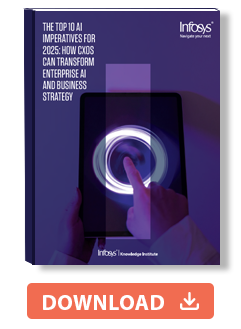Executive summary
In 2024, we introduced the top 10 imperatives for AI. We wrote about the importance of data over models; hallucinations as features and not bugs; the growing importance of fine-tuned models, and responsible data management to ensure increased performance doesn’t entail increased liability and risk.
Now as we move into 2025, we have learned a few more things about AI business strategy. It’s simply not that easy to derive value from AI. Clients we speak to have been trapped in pilot purgatory, with success factors like improved productivity, lower cost, and risk mitigation hard to achieve. Part of this is because some critical foundations aren’t in place yet. Recent research in the Enterprise AI Readiness Radar by the Infosys Knowledge Institute found that just 2% of enterprises globally are fully prepared for enterprise AI across the five foundational elements of strategy, governance, talent, data, and technology (Figure 1).
Figure 1. Enterprises lag on readiness
Source: Infosys Knowledge Institute
In the next year, as enterprise moves from AI experimentation to expecting business value from AI, they will need an AI strategy that considers technical, organizational, and human factors.
Choice of AI model is all important, as different models offer varying levels of performance, accuracy, scalability, and regulatory compliance. So is the ability to give the AI independence to accomplish business goals with minimal human involvement — a behind-the-scenes workhorse of sorts. This “agentic” AI is an evolution from knowledge-based, generative AI-powered tools to systems that use foundation models to execute complex, multistep workflows, independently interacting in a dynamic world.
Because the AI landscape is very fast-moving, enterprises will need to avoid vendor lock-in and adopt a poly AI architecture. This allows businesses to deploy a range of AI services and tools that can be easily changed or updated while offering a consistent interface between the tools and the users. This reduces fragmentation and increases efficiency.
Finally, for meaningful change, technology must be built with both speed and scale; experimentation and final rollout of AI products require a two-stage approach, leveraging an AI foundry for experimentation and an AI factory model for industrializing the product at scale. The first five imperatives below tell this story.
The final five imperatives this year give further clues about how to bring this technology to life, both internally to the organization, and for business growth. Enterprises need to address challenges as well as seek out opportunities to maximize the benefits of AI.
Generative AI models can be power-hungry, emitting hundreds of tons of carbon. With nearly half of companies on the Forbes 2000 list aiming for net zero, finding ways to create energy-efficient AI models is a clear priority.
Similarly, with so few enterprises data-ready, now is the time to institute data governance and hygiene measures, ensuring the data that feeds the AI is privacy- and regulatory-compliant. We also consider how to build the right implementation strategy, choosing use cases based on high-impact areas in the value chain.
When scaling enterprise AI, it’s important to bring your people along with you, and to ensure that what you do doesn’t just replace jobs but uses AI to improve productivity and work more effectively.
For this, in our last two imperatives, we introduce a three-tiered competence framework, and we recommend better change management, a product-centric operating model, and using AI to expand existing business operations.
Enterprise AI is here to stay, and a well-formed business strategy is synonymous with an AI strategy.
The 10 AI imperatives for 2025 are
1. Smaller and more focused models
Many enterprises began their AI journey last year by using closed-access large language models (LLMs), defined as having more than 40 billion parameters, given their capabilities in text and image generation.
However, as we move into 2025, small and medium-sized language models, with between 2 billion and 7 billion parameters, will dominate the enterprise landscape (Figure 2). Infosys has created two of these models for finance and operations, and there are similar offerings from IBM and Meta, among others.
Often based on open-source architectures, these models offer a balance of performance, efficiency, and cost-effectiveness, and excel in task-specific applications.
They provide greater accuracy, lower latency, and higher throughput than their larger siblings, and importantly, consume far less energy and compute. They also provide a foundation for companies to tune them to their specific requirements.
Lower costs, lower risk, data containment, and greener compute all stack up to make this trend a growing force in business.
Figure 2. The sweet spot
Source: Infosys
2. Agentic AI as the future of enterprises
Enterprises, their employees, and their jobs started to see the impact of AI in 2024. Some businesses began to use AI tools to help employees with tasks and to boost productivity, and to offer enhanced content intelligence and other domain-specific use cases. However, according to our AI readiness research, only 12% of enterprises provided their employees with training on how to use AI tools effectively.
The workforce of 2025-26, however, will be increasingly guided by AI agents, with human supervision and oversight (Figure 3).
Figure 3. AI agents will reshape work
Source: Infosys Consulting
This approach is known as agentic AI and is made up of systems that have a degree of autonomy and act on their own to achieve specific goals. They can make decisions, plan actions, and learn from experiences. In the past year alone, Google, Microsoft, OpenAI, and others have invested in software libraries and frameworks to support agentic functionality.
Unlike traditional assistive tools, these intelligent agents function as behind-the-scenes workhorses. For example, in software development, one agent might be responsible for writing code, another for testing, and another for critiquing. A virtual assistant, for example, could plan and book a complex personalized travel itinerary, handling logistics across multiple travel platforms.
Leaders should use agentic AI to increase productivity, transform processes, and ensure agents play a pivotal role in making complex workflows faster and more efficient through a natural language interface.
3. Evolving processes from static to adaptive
AI adoption is happening in waves, with AI software engineering and enterprise AI assistants happening now — this is the first wave. In the second wave, coming in 2025, AI will transform customer service, operations, sales and marketing. The third wave will be business process and experience reimagination.
2025 will see leading enterprises embed AI, including generative AI interfaces, deeply into business operations, preparing the ground for more valuable AI implementations (Figure 4). Embedding AI in this way is the bedrock of large-scale AI adoption, where workflows evolve from static processes to adaptive AI systems. Adaptive systems allow for real-time AI-driven decision-making as they continuously learn from new data, help users access insights in real time, and adjust workflows as needed.
Figure 4. AI must be integrated into the business
Source: Infosys Knowledge Institute
To succeed, businesses must be prepared to view AI not as a tool but as an integral part of their long-term strategy and drive meaningful change in how they operate and make decisions. They must also ensure appropriate governance of key processes.
4. Flexibility and leverage through poly AI
Most enterprises will likely end up having a mix of AI deployments across domain-specific use cases and wider customer journeys. Enterprises should look to a poly AI architecture, which provides an interface layer between users and AI tools and services (Figure 5). This reduces the issues of vendor lock-in and provides the flexibility to use the best-fit option and cross-leverage AI capabilities across user experiences and business processes. A poly AI architecture also reduces fragmentation, increases efficiencies, and ensures consistent performance across deployments.
A poly AI approach also ensures various tooling and processes are transparent, measured, and monitored across multiple hyperscalers.
Using this architecture will put the enterprise ahead of the 98% of organizations that aren’t ready across all five dimensions, according to our AI readiness research.
Figure 5. Implement poly AI for efficiency
Source: Infosys
5. Innovation through an AI foundry and factory
The first four imperatives — smaller and focused models, agentic AI, reimagined processes and experiences, and poly AI architecture — can only be built if the talent is available. However, this is a challenge for many: just 35% of enterprises are AI-ready on the talent dimension, according to AI Readiness Radar.
Enterprises must build a team that can rapidly build, test, and implement AI tools, processes, and services. Companies should invest in an internal development platform that provides software teams with all the tools and infrastructure they need to start piloting, building, and deploying solutions.
Some companies will take a two-stage approach, first establishing an AI foundry to experiment with and incubate new technologies, develop new patterns, and try different use cases, after which an AI factory will turn the learnings from the foundry into products (Figure 6). This approach helps balance and manage the risks associated with AI while scaling adoption within the enterprise.
Figure 6. Innovate at speed and scale
Source: Infosys
6. Greener, lower-cost hardware and models
Now that we’ve got the innovation factory set up (Imperative #5), how can business leaders ensure we’re keeping costs low and compute as green as possible?
Sustainability is a crucial element of responsible AI design, addressing the environmental impact of AI systems.
As AI models and infrastructure consume significant energy, it's vital to develop more efficient, compact models that can run on less power-hungry hardware like CPUs instead of GPUs (Figure 7).
Figure 7. LLMs challenge sustainability goals
Source: Infosys Knowledge Institute
Enterprises should prioritize the use of smaller, more efficient models to reduce their carbon footprint while maintaining functionality. The optimization of data centers, including the use of renewable energy sources and advanced cooling systems, is also essential for sustainable AI operations.
AI itself can contribute to sustainability efforts by optimizing power consumption in data centers and enhancing overall system efficiency without compromising service level agreements. Sustainable AI involves implementing lifecycle assessments for AI projects and considering environmental impact throughout all stages of development and deployment.
7. Fingerprinted data for better governance
In prior research, we found that data accuracy, processes, and accessibility have a significant impact on successful AI development.
However, the Infosys Knowledge Institute’s AI Readiness Radar found that data is an area in which enterprises are least ready (just 17% have an effective data estate). In fact, 30% of enterprises rated data governance processes used for AI as poor, increasing AI risks.
Preparing data infrastructure includes having systems cleanse and then fingerprint data so that it is transparent, and companies know what is present where (in each piece of data) across data stores.
Companies can use this fingerprint to establish data correlations and conduct governance activities.
Additionally, companies must know how to handle structured and unstructured data, including traditional analytical data, transactional data, synthetic data, and ecosystem data, generated by users or machines (Figure 8).
Figure 8. Data governance is paramount
Source: Infosys
Enterprises should also establish a data or AI governance entity that is in charge of this data stewardship.
8. Value chain-to-AI capability mapping
While AI can boost productivity by as much as 40%, according to our AI Readiness Radar, its further potential lies in elevating the quality of work from good to exceptional, according to insights from a World Economic Forum 2024 study.
CXOs should develop a strategic AI value map to identify high-impact business areas across the organization rather than pursuing siloed use cases.
This approach should consider the five AI evolutionary capabilities — from AI as a general-purpose tool to AI as a collaborator to autonomous AI agents — and map them to activities (Figure 9). Further analysis should consider factors such as value creation, cost management, data availability, and required skillsets for successful implementation.
The primary use case and its supporting activities comprise the core business process. For example, in retail, this includes logistics, operations, and customer service. Enterprises should then map the level of automation needed to fulfill each activity.
Strategic mapping and deployment of AI across the organization will help take the business to the next level.
Figure 9. AI evolutionary capabilities
Source: Infosys
9. AI competency through upskilling and product-centricity
To bring AI to life, every enterprise needs a talent strategy. An AI-first enterprise also needs a change management strategy and a target operating model, increasingly viewed as product-centric.
First, talent needs to go broad and deep on AI. This approach should aim to elevate human intelligence and capabilities across the organization, ensuring the company remains competitive in an AI-driven landscape. For instance, Infosys' three-tiered competence framework has:
- AI aware: Ensure all employees have a basic understanding of AI tools for effective collaboration and co-creation.
- AI builders: Develop people who can use AI skills to create AI-embedded or AI-reimagined solutions.
- AI masters: Nurture experts who can design models and innovative methods that work at scale, reducing costs and adding value to the business.
By adopting this approach, organizations can create a workforce equipped to collaborate effectively with AI at various levels of sophistication.
Change management should include managing AI adoption and transition, leadership alignment, and a communications plan with regular channels and cadence.
Third, the operating model should be designed so that teams can work in an agile, product-centric approach (Figure 10). In this organization model, AI products and services are created by cross-functional teams, grouped to orchestrate an end-to-end customer journey, which increases business velocity and experimentation.
Figure 10. Deploy a product-centric model
Source: Infosys Knowledge Institute
10. AI for business growth
AI shouldn’t be viewed simply as a cost-cutter or productivity enhancer. Rather, it can be used to do things that weren’t possible before, leading to new ways of operating and doing business.
The financial services industry, being a fast mover in AI, often indicates how follower industries will use AI in business strategy. We can see from our banking index research that although reducing costs is still the biggest strategic priority, transforming business models is also growing in importance, and driving business growth isn’t far behind (Figure 11).
Figure 11. Transforming business models a key CXO priority
Source: Infosys
AI can process vast amounts of data to identify potential new growth markets. It can also identify new channels that might not have been considered, especially in an international context.
AI can also be used for things that humans can’t do, such as identifying patterns that humans miss. In research-intensive fields, it accelerates progress by enabling rapid exploration of complex problems.
However, this transformation brings challenges, such as mismatches between existing skills and emerging job requirements. To address these challenges and prevent the exacerbation of existing inequalities, prioritizing education on AI and its implications is crucial. Inclusive development practices, transparency, and ongoing education initiatives are essential for creating AI systems that not only benefit individual users but also serve the greater good and build stakeholder trust.
















